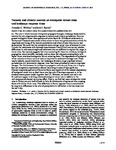Tectonic and climatic controls on knickpoint retreat rates and landscape response times
| dc.contributor.author | Whittaker, AC | |
| dc.contributor.author | Boulton, Sarah | |
| dc.date.accessioned | 2014-06-26T12:27:09Z | |
| dc.date.accessioned | 2014-06-26T12:27:14Z | |
| dc.date.accessioned | 2014-06-26T12:27:38Z | |
| dc.date.available | 2014-06-26T12:27:09Z | |
| dc.date.available | 2014-06-26T12:27:14Z | |
| dc.date.available | 2014-06-26T12:27:38Z | |
| dc.date.issued | 2012-05-18 | |
| dc.identifier.issn | 0148-0227 | |
| dc.identifier.issn | 2169-9011 | |
| dc.identifier.other | F02024 | |
| dc.identifier.uri | http://hdl.handle.net/10026.1/3042 | |
| dc.description.abstract |
<jats:p>The rate at which transient knickpoints propagate through a landscape fundamentally controls the rate of geomorphic response to tectonic and climatic perturbation. Here we present knickpoint retreat rates upstream of active faults for 19 bedrock catchments in Turkey and 11 bedrock catchments in Italy where we have very good constraints on both the magnitude and timing of the tectonic perturbation and where climate histories are well documented. We show that the knickpoints have average retreat rates of between 0.2 and 2 mm/yr for catchments with drainage areas between 6 and 65 km<jats:sup>2</jats:sup> and we test whether differences in rock mass strength and catchment size are sufficient to explain this range in retreat rates. Our analysis suggests that even accounting for these two variables, knickpoint propagation velocities differ markedly, and we show that channels crossing faults with higher throw rates have knickpoints that are retreating faster. The dependence of knickpoint retreat velocity on throw rate is at least as important as catchment drainage area. These results indicate, counterintuitively, that landscapes forced by large amplitude tectonic perturbations will have shorter response times than those perturbed by smaller amplitude changes. The link between the knickpoint propagation velocity and throw rate is largely (but not completely) explained by channel narrowing in areas of high uplift rate. Channel steepening upstream of the active faults may explain all of the residual dependency of knickpoint retreat rate on fault throw rate, but only if the slope exponent, <jats:italic>n</jats:italic>, in the standard stream power model is greater than 1.3. However, we cannot rule out a role for sediment supply in driving enhanced knickpoint retreat rate in addition to the well‐documented channel narrowing effect. Finally, we find that mean knickpoints retreat rates in Turkey are only half of those in Italy, for catchments of equivalent size, crossing faults with similar throw rates. This difference in fluvial response time is accounted for by long‐term differences in the ratio of precipitation to infiltration in the two areas over the last 1 My.</jats:p> | |
| dc.format.extent | ? - ? (19) | |
| dc.language | en | |
| dc.language.iso | en | |
| dc.publisher | American Geophysical Union (AGU) | |
| dc.relation.replaces | http://hdl.handle.net/10026.1/3040 | |
| dc.relation.replaces | 10026.1/3040 | |
| dc.relation.replaces | http://hdl.handle.net/10026.1/3041 | |
| dc.relation.replaces | 10026.1/3041 | |
| dc.title | Tectonic and climatic controls on knickpoint retreat rates and landscape response times | |
| dc.type | journal-article | |
| dc.type | Article | |
| plymouth.author-url | https://www.webofscience.com/api/gateway?GWVersion=2&SrcApp=PARTNER_APP&SrcAuth=LinksAMR&KeyUT=WOS:000304264300001&DestLinkType=FullRecord&DestApp=ALL_WOS&UsrCustomerID=11bb513d99f797142bcfeffcc58ea008 | |
| plymouth.edition | 117 | |
| plymouth.issue | F2 | |
| plymouth.volume | 117 | |
| plymouth.publication-status | Published | |
| plymouth.journal | Journal of Geophysical Research | |
| dc.identifier.doi | 10.1029/2011JF002157 | |
| plymouth.organisational-group | /Plymouth | |
| plymouth.organisational-group | /Plymouth/Faculty of Science and Engineering | |
| plymouth.organisational-group | /Plymouth/Faculty of Science and Engineering/School of Geography, Earth and Environmental Sciences | |
| plymouth.organisational-group | /Plymouth/REF 2021 Researchers by UoA | |
| plymouth.organisational-group | /Plymouth/REF 2021 Researchers by UoA/UoA07 Earth Systems and Environmental Sciences | |
| plymouth.organisational-group | /Plymouth/Users by role | |
| plymouth.organisational-group | /Plymouth/Users by role/Academics | |
| dc.identifier.eissn | 2169-9011 | |
| dc.rights.embargoperiod | Not known | |
| rioxxterms.versionofrecord | 10.1029/2011JF002157 | |
| rioxxterms.licenseref.uri | http://www.rioxx.net/licenses/all-rights-reserved | |
| rioxxterms.type | Journal Article/Review |


